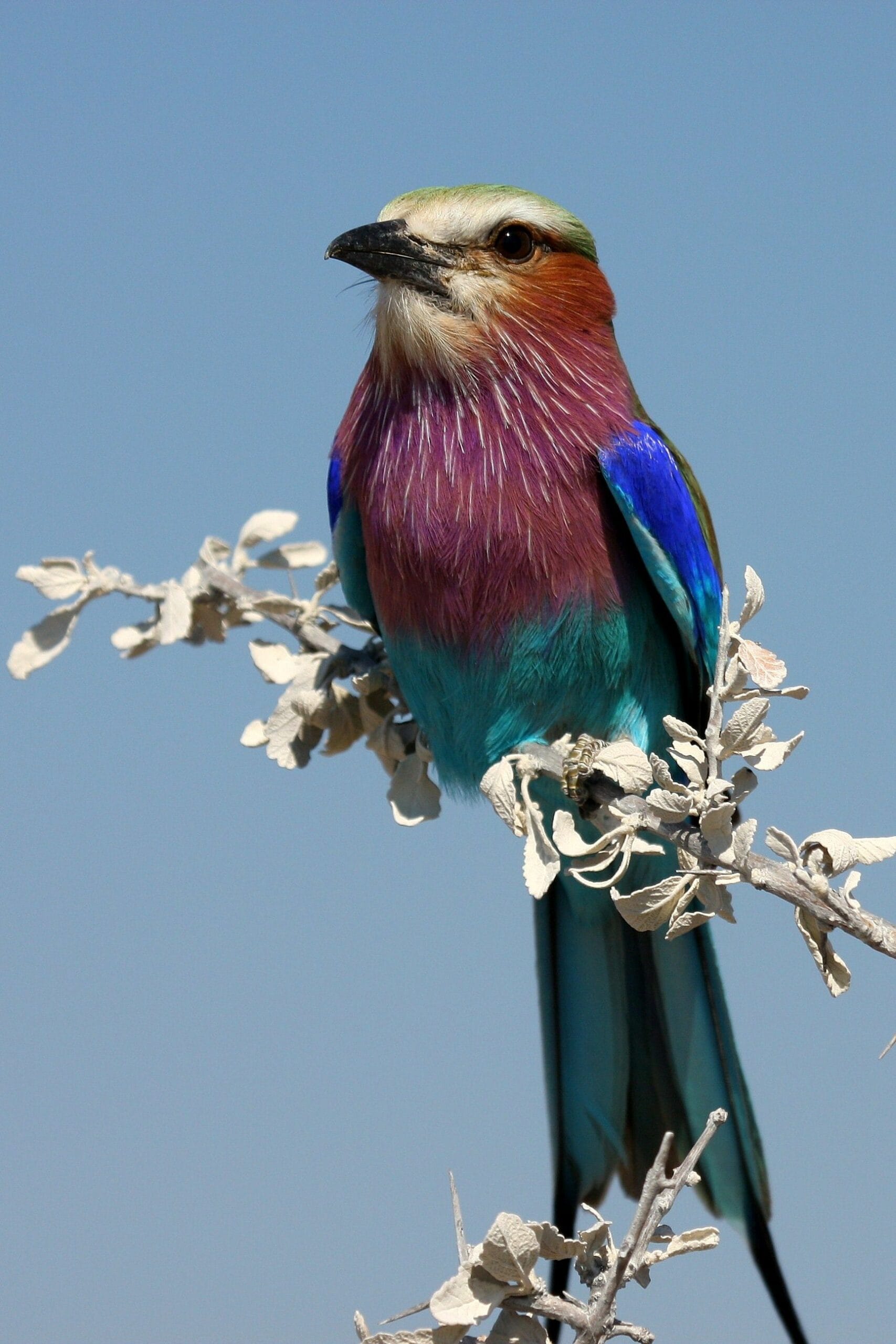Picture a bird with a vibrant lilac chest soaring through the African skies. This is the Lilac-Breasted Roller, a stunning creature that captivates with its beauty and plays a vital role in the savanna ecosystem. This guide explores the world of this remarkable bird, from its distinctive appearance and intricate feeding habits to its conservation status and the mysteries surrounding its vocalizations.
Unveiling the Lilac-Breasted Roller
The Lilac-breasted Roller (Coracias caudatus)—a name as enchanting as the bird itself—is a true jewel of the African savanna. Its vibrant plumage and aerobatic displays make it a memorable sight. Let’s delve into the fascinating details of this avian wonder.
Appearance: A Kaleidoscope of Colors
These medium-sized birds, typically 35-38 cm long (about the length of a ruler), boast a striking combination of colors. Their lilac chest contrasts beautifully with rusty-orange cheeks and an emerald green crown. Adding to their elegance are long tail streamers that flow gracefully during flight, enhancing their already impressive aerial maneuvers.
Habitat and Distribution: Savanna Sojourner
The Lilac-Breasted Roller is native to eastern and southern Africa, with its range extending slightly into the southern Arabian Peninsula. They favor open woodlands and savannas, thriving in wide-open spaces where they can hunt and perform their dazzling aerial acrobatics. They generally avoid dense forests, preferring landscapes that offer clear visibility for hunting and displaying. You might even spot them at Coulette, a scenic lake situated within such a habitat.
Diet: An Insectivore’s Appetite
As insectivores, Lilac-Breasted Rollers primarily consume insects, playing a valuable role in regulating insect populations within their ecosystem. This natural pest control helps maintain the delicate balance of the savanna. Some research suggests their diet may also include small lizards and other ground-dwelling prey.
Courtship: A Ballet in the Sky
When seeking a mate, the Lilac-Breasted Roller engages in elaborate courtship displays, performing intricate loops, dives, and rolls with remarkable precision and grace. These aerial ballets likely serve to attract potential partners and demonstrate their fitness.
Nesting and Family Life: Home Sweet Hole
Lilac-Breasted Rollers are monogamous, typically mating for life. They nest in tree cavities, sometimes on branches, often utilizing existing holes or creating simple scrapes. The female lays 2-4 eggs, and both parents share incubation and chick-rearing duties.
Conservation Status: A Look Ahead
The Lilac-Breasted Roller is currently categorized as Least Concern by the IUCN, indicating it’s not currently facing imminent extinction. However, ongoing monitoring remains crucial, as habitat loss due to deforestation and agriculture poses a potential future threat. Protecting their habitat is vital for their long-term survival. While you’re exploring conservation and natural wonders, consider a visit to the Crater of Diamonds State Park, a testament to the wonders our earth holds.
Are Lilac-Breasted Rollers Endangered?
Although a sight to behold, questions arise about the Lilac-breasted Roller’s long-term survival. Currently classified as Least Concern by the IUCN, their stable population seems secure for now. This positive assessment is largely due to their prevalence within protected areas like national parks and reserves, which buffer against habitat destruction.
However, their confinement to these safe havens raises concerns about potential vulnerabilities outside these protected zones. Habitat loss due to agriculture and development poses a significant threat if it encroaches upon their preferred woodlands. While current numbers offer reassurance, ongoing research and monitoring are crucial for a comprehensive understanding of their situation.
Some experts believe focusing solely on population size might overlook subtle threats outside protected areas. Further investigation into food source changes and pesticide impacts could provide valuable insights. Even stable populations are susceptible to unforeseen challenges, like climate change, which could disrupt ecosystems and impact their food supply or breeding cycles. Continuous monitoring and research are vital for a nuanced understanding of their true status, ensuring these vibrant birds continue gracing our skies for generations to come.
What Noise Does a Lilac-Breasted Roller Make?
Beyond their visual splendor, Lilac-Breasted Rollers possess a unique vocal repertoire. Their most common call, a harsh, grating “rak rak rak,” often echoes through the woodlands, likely serving as a contact call or territorial announcement.
During courtship, males amplify their aerial displays with a boisterous “kaaa, kaarsh,” a raucous serenade aimed at impressing potential mates. Quieter, scratchier calls, used while perched, likely play a role in territorial defense or other nuanced communication.
Recent research suggests their vocalizations are more complex than previously thought. Recordings reveal a broader range of calls, hinting at a more intricate communication system. Ongoing studies aim to decipher these sounds, potentially uncovering insights into predator warnings or preferred foraging locations.
Do Lilac-Breasted Rollers Migrate?
The question of Lilac-Breasted Roller migration isn’t straightforward. It depends on the subspecies. The nominate subspecies (Coracias caudatus caudatus) is largely resident, engaging in post-breeding dispersal for food rather than true migration. They may move to different areas within their range, following food sources, but return to their breeding grounds with the onset of rains.
In contrast, the Lilac-throated Roller subspecies (Coracias caudatus lorti) undertakes a true migration, journeying between northeast Kenya and northwest Somalia for breeding, similar to other migratory birds.
While the overall Lilac-Breasted Roller population remains stable, localized declines raise concerns. Understanding the factors influencing these local trends requires further research, encompassing habitat loss, food availability, and other environmental influences. Ongoing studies will enhance our comprehension of these complexities, contributing to more effective conservation strategies.
| Feature | Description |
|---|---|
| Scientific Name | Coracias caudatus |
| Common Name | Lilac-breasted Roller |
| Size | 35-38 cm |
| Diet | Primarily insects, may include small lizards and other ground prey |
| Habitat | Open woodlands and savannas |
| Conservation Status | Least Concern (IUCN) |
| Distinctive Features | Striking plumage, long tail streamers, acrobatic courtship displays |
| Behavior | Aerial acrobatics, monogamous, nests in tree cavities |
| Ecological Role | Insect population control |
This deeper dive into the Lilac-Breasted Roller’s world, from its vibrant plumage and aerial displays to its complex vocalizations and movement patterns, offers a richer understanding of this remarkable bird and the importance of its conservation. As our knowledge of the natural world constantly evolves, there’s always more to discover about the Lilac-Breasted Roller and its place in the vibrant tapestry of the African savanna.
- Revolution Space: Disruptive Ion Propulsion Transforming Satellites - April 24, 2025
- Race Through Space: Fun Family Game for Kids - April 24, 2025
- Unlocking the Universe: reading about stars 6th grade Guide - April 24, 2025

















2 thoughts on “Lilac-Breasted Roller (Coracias caudatus): A Comprehensive Guide”
Comments are closed.